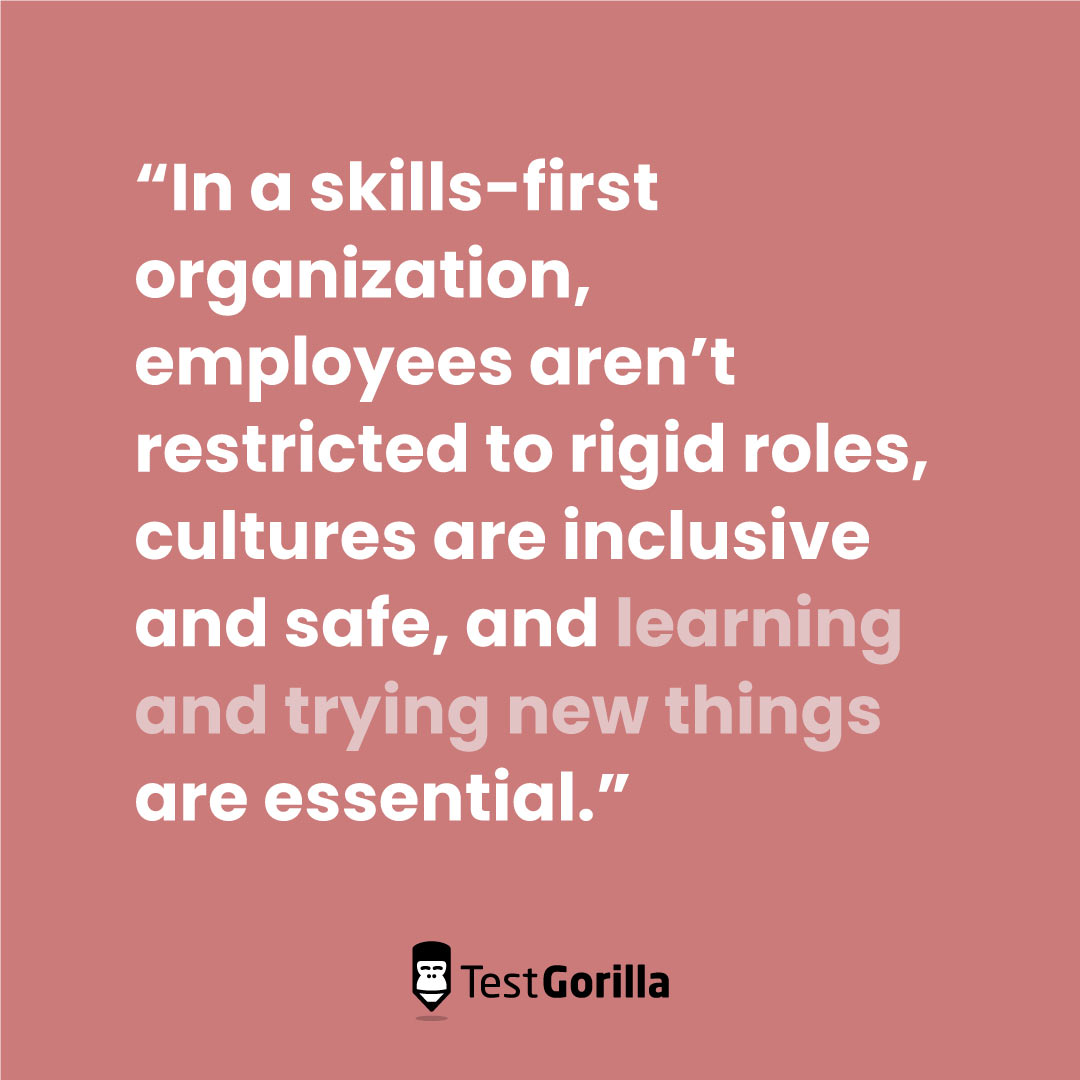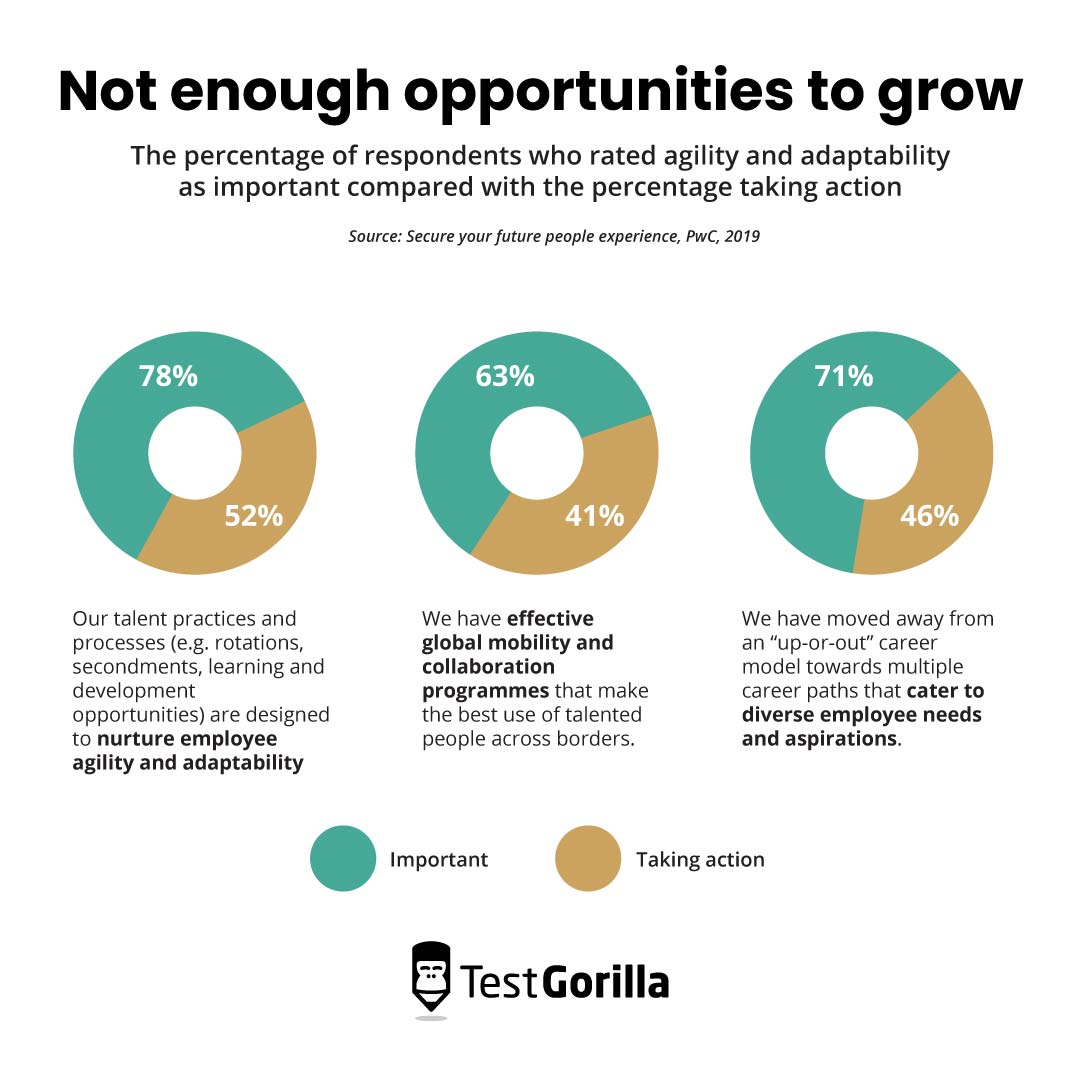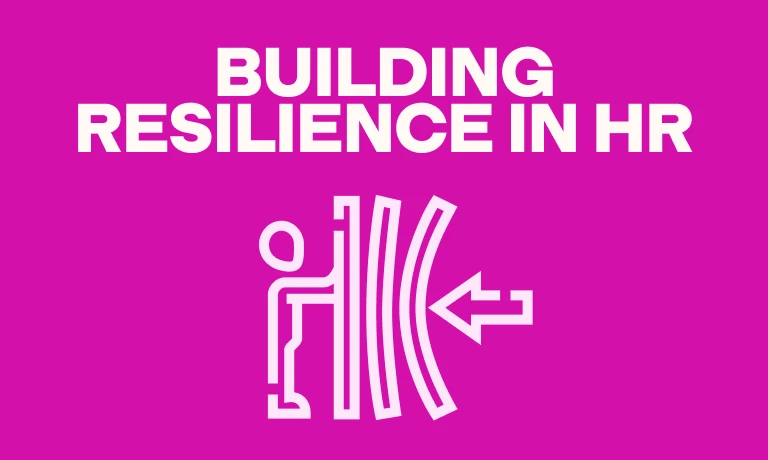How skills-based organizations increase their agility and become more adaptable
We live in strange times, with what seems like a “once-in-a-lifetime event” occurring every few months.
Market conditions, hiring practices, and the working landscape itself are constantly shifting.
This means that organizations need agility and flexibility to properly respond. Companies need processes and people that are ready to solve problems and take on sudden challenges with a healthy mindset and plan.
Skills-based organizations are companies that put skills first when hiring, developing talent, and making decisions – and they’re built for agility.
Skills-based practices are more than an effective hiring strategy, and organizations with a skills-first mindset are more ready to adapt to sudden changes.
In a skills-first organization, employees aren’t restricted to rigid roles, cultures are inclusive and safe, and learning and trying new things are essential.
In this article, we discuss organizational agility and the importance of adapting to events and disruptions, as well as the top four reasons why skills-based organizations are more flexible and agile than a standard company.
Countless recent events have impacted the working landscape
It’s natural that a global event would impact organizations, but the frequency of unprecedented events in recent history has left many companies struggling.
In the past decade, we’ve faced market changes, technological disruptions, and even a global pandemic.
More specifically, these recent events include (but aren’t limited to):
The COVID-19 pandemic
The Great Reshuffle
Technological advancements, such as AI and crypto
Supply chain issues
Global protests for equality and fair treatment
These events have forced thousands of companies to act and have left many rethinking how their organization responds to sudden change.
Here are a few ways organizations have had to react to change:
Because of the pandemic, thousands of companies adopted hybrid and remote work when they had previously never considered it
Many organizations have had to research cryptocurrency, hire blockchain developers, and set up a blockchain due to technological advancements
Many leaders have begun promoting corporate social justice to show that they won’t take injustice and inequality lying down
Organizations are reconsidering their hiring strategies to better attract and retain shuffling employees because of the Great Reshuffle
The Great Reshuffle is an excellent example of why companies need to consider their agility and adaptability in case of sudden change.
It’s also a great example of how skills-based organizations have an easier time acting on their feet.
When the recruiting world is so uncertain, you need a strategy to efficiently attract shuffling workers, and skills-based practices help you react quickly and appropriately.
Skills-first organizations are able to open their talent pools to attract a greater number of qualified workers that have been caught in the shuffling mix.
This focus on skills also helps retain current employees who need incentives to stay in the company, like improved culture and wellbeing or more learning opportunities.
A recent study by Lever found that 31% of employees would take a pay cut for a new role they were more satisfied with. A further 61% would start looking for a new job if their company didn’t help them start a new role.
Adopting a skills-first mindset also enables you to have a proactive strategy rather than a reactive strategy, which means you aren’t reacting when something unexpected happens, you already have a plan in place.
It’s the difference between buying a carton of eggs when you’re hungry with no groceries in the fridge versus buying a carton of eggs when you already have some (but you know your famous egg casserole is going to be a hit at the family picnic next week).
Building these strategies is essential in the age we live in. This complex landscape is rapidly changing, and companies need to be agile and flexible to adapt.
Why companies need to be agile and adaptable
Agility is essential to organizations because it helps them react quickly and effectively to changes in the market.
We’ve encountered more disruptions in the past decade alone than we have in the previous few decades combined, and companies have to prepare themselves to respond in a flexible way.
Why is agility important? And what’s the consequence of an organization that doesn’t have an agile strategy?
Companies that have to suddenly react to uncertainty may make hasty decisions that end up being a detriment to their financial performance, brand image, and values.
For example, Walmart experienced critical overstaffing after hiring new employees en masse to cope with post-pandemic stress and pressure.
Walmart reported a 24.8% decline in profits, which led to mass layoffs.
Another example is Amazon, which despite trying to attract talent during the Great Reshuffle, is experiencing an annual turnover rate of 150%, at double the industry average.
Experts suggest this could be due to a lack of inclusivity or fairness and an absence of a healthy company culture.
As you can see, many of even the largest companies struggle when it comes to agility and making the appropriate response to change.
One survey found that 78% of respondents said it’s important for a company’s talent practices and processes to be designed to nurture employee agility and adaptability, but only 52% said they’re taking action to make it happen.
The same survey found that 71% of organizations believe it’s important to develop diverse, agile career paths that cater to specific employee needs, but only 46% are taking action.
There’s often a discrepancy between what we think is important and what we act on. Change triggers fear, and we could end up relying on traditional methods because they’re “safe.”
But when we don’t take steps to innovate, the worst can happen. Adopting a learning mindset and focusing on innovation is imperative in unprecedented times.
A proactive approach helps companies respond to situations and act on their feet. Rather than reacting to a sudden change, they’re creating a long-term strategy that prepares them for flexibility.
Because of the Great Reshuffle, many companies are rushing forward with a “reactive approach.” One study showed that 61% of businesses admit to settling for a candidate that did not sufficiently match the job role, and 56% admit to rushing the hiring process.
Adaptability isn’t something that’s determined when a company is being built. It isn’t a natural skill. Agility and adaptability are skills that companies build and nurture.
That’s why we recommend a skills-based approach.
A skills-first mindset is a core value you adopt deep into your organization’s processes. Skills-based practices organically reach outward and affect every branch of the company, setting you up for a long-term, proactive strategy.
A strategy that reduces mis-hires and increases retention.
According to our State of Skills-Based Hiring report, 92.5% of organizations that use skills-based practices saw a reduction in mis-hires in 2022. In addition, 91.2% of organizations saw an increase in retention.
Let’s go deeper into how skills-based practices make this happen.
The best insights on HR and recruitment, delivered to your inbox.
Biweekly updates. No spam. Unsubscribe any time.
How skills-based practices create an adaptable workforce
So how do skills-first organizations act quickly and appropriately during tough times and sudden crises?
Skills-based practices were designed for long-term, reliable success by prioritizing skills, the wellbeing of your people, and flexibility.
Let’s take a closer look. But first, here’s a quick summary:
Empowers skills-based job roles that are more flexible and fluid
Facilitates learning and continuous improvement
Expands your talent pool
Nurtures an inclusive, healthy culture
1. Empowers skills-based job roles that are more flexible and fluid
Traditional job roles are usually rigid. An employee sticks to their responsibilities and never deviates.
For example, the extent of a junior marketer’s responsibilities surrounds creating and managing marketing campaigns. It doesn’t matter if they have skill or experience in IT; they can’t help with quality assurance even when the IT team is short-staffed.
Skills-based hiring moves away from this type of traditional “job role” and focuses more on problems to solve and outcomes to achieve.
Skills-first organizations are moving away from these rigid jobs because they need a flexible workforce that can be quickly organized and reorganized depending on their current challenges and opportunities.
Companies need this level of agility in the fluctuating environment we find ourselves in.
Let’s take our above example in a skills-based environment.
Our junior marketer primarily completes their marketing tasks, but due to their experience in IT, they can complete cross-departmental responsibilities whenever necessary.
Skills-based organizations focus on employee skills instead of job titles. This ensures that companies can respond to many sudden changes smoothly, such as a spike in turnover or a shortage of specific skills.
For more on this topic, read our article on how the future of work is moving away from traditional jobs.
2. Facilitates learning and continuous improvement
Continuous improvement and skills-based practices go hand-in-hand.
Upskilling and reskilling are the backbone of a skills-based organization, and they’re essential to building agility and adaptability.
Learning and development help agility in two main ways:
Encourages more multipotentialites in your company
Instills a learning mindset in employees and leaders so they’re ready to learn new things and take on new challenges
A mindset of continuous improvement is crucial for every organization and is the number one way to adapt to change.
This mindset encourages the following traits in employees:
Growth
Curiosity
Creativity
Exploration
Eagerness for opportunity
This mindset empowers employees to be more innovative and creative, leading to better, more flexible problem-solving.
Here’s an example of a status quo-driven mindset versus a learning mindset:
Status quo mindset | Learning mindset |
“I should do this like I always do. What if it goes wrong?” | “I’ll go ahead with a flexible mindset so I can adapt to the best solution.” |
“I need to prevent something negative from happening.” | “I could make something amazing happen.” |
“I need to know what’s happening so I can apply a tried-and-true solution to it.” | “I’ll explore new possibilities, strengthening the process and potentially solving future problems.” |
Take note that this type of mindset and the ability to explore new ideas can only develop in a psychologically safe workplace.
A psychologically safe workplace is a place where employees are able to take risks, ask questions, and make mistakes.
3. Expands your talent pool
If you need to fill an open role, a restricted talent pool is a detriment to your agility and adaptability.
Skills-based hiring reaches beyond borders and expands your talent pool, which enables you to be agile in hiring and covering new skill demands.
Here are some of the ways that skills-based hiring expands your talent pool:
Less reliance on work experience
Less reliance on college degrees
Doesn’t require the use of resumes
Reduced unconscious bias
It was for these reasons that Kelly Chuck, a program manager at LinkedIn, was hired after shuffling from her last company. She had this to say:
“I was hired based on my demonstrated skills and potential to grow. If my hiring managers were looking for an advanced degree or years of experience, I wouldn’t have gotten the job.”
Skills-based practices also open an unconventional talent pool: your internal talent pool.
A focus on skills and capabilities facilitates internal mobility, which makes your workforce adaptable and agile. Employees are able to cover responsibilities quickly and efficiently with less cost to employers.
If a position suddenly vacates, you can move an internal candidate into the role for much less cost. They already know company culture and policies, too, so onboarding is much simpler.
Many events benefit from internal mobility, but it’s particularly useful for talent shortages like the Great Discontent.
For more insights on this topic, check out our guide on internal talent marketplaces.
4. Nurtures an inclusive, healthy culture
A study in 2018 found that diverse connections and emotional support help our wellbeing and learning, particularly in times of uncertainty and stress.[1]
An organizational culture that is supportive, inclusive, and strong is more able to handle change and adapt accordingly.
For example, many companies struggled with how to respond to the many protests and displays of civil unrest following the killing of George Floyd, with many of them being accused of “brand activism.”
But a company that has a foundation of inclusivity and diversity not only has a better understanding of how to approach a delicate situation like that but also has a strong brand reputation of inclusivity, which helps prevent accusations of virtue signaling.
Inclusivity is an important part of adapting to change, and skills-based organizations promote, build, and nurture healthy, inclusive cultures.
A skills-first organization builds this environment by prioritizing “culture add” over “culture fit.”
Culture fit has been around for a long time, but we believe that its opportunity for bias means it has overstayed its welcome.
Culture add, on the other hand, evaluates a candidate’s values and aligns them to your organization’s, while still valuing and respecting diversity and differences. You can learn more in our post about our Culture add test.
It’s also important to note that skills-based practices improve and promote employee wellbeing, leading to a stronger company culture. This includes better-utilized skill sets, positive mental health impacts, and more opportunities for career growth.
Adopt skills-based practices to proactively increase agility
We live in a world with shifting priorities, sudden changes, and many life-changing events. It can seem overwhelming, but when an organization is adaptable, it can bend to respond to almost anything.
Skills-first organizations have a powerful edge when it comes to agility – flexible job roles, a learning mindset, an open talent pool, and an inclusive culture.
And all of these are long-term, proactive strategies that you build over time.
For more information on the structure of a skills-based organization, read our article on the changing role of managers in a skills-first organization.
To assess two key elements of agility – openness and emotional stability – use our Big 5 test in your next pre-employment assessment.
Source
Mathieu, Michael; Eschleman, Kevin J; Cheng, Danqiao. (October 18, 2018). “Meta-analytic and multiwave comparison of emotional support and instrumental support in the workplace”. PubMed. Retrieved April 28, 2023. https://pubmed.ncbi.nlm.nih.gov/30335420/
You've scrolled this far
Why not try TestGorilla for free, and see what happens when you put skills first.

















